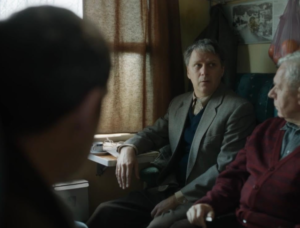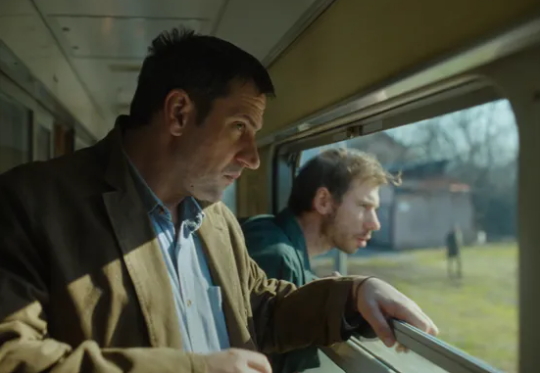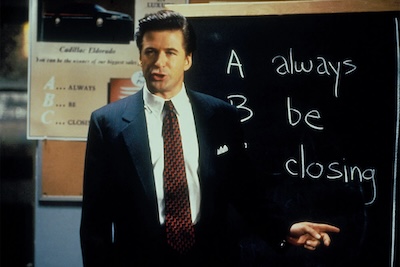Imagine waking up as your train ride comes to a slow stop. You are not at your destination, so you pile out into the corridor to see what us the hold up. Most of the individuals who stopped your journey carry large guns, and they are being let into the train to inspect who is on board. It’s a terrifying thought but everyone assumes they are welcome to do what they please. Nebojša Slijepčević’s Short Film Palme d’Or winning film confronts every audience member with a simple question: would you be able to speak out against those who wish to harm your fellow man?
**This interview contains spoilers for The Man Who Could Not Remain Silent**
I was surprised to learn that the action in Slijepčević’s film is based on real events. The Croatian director was not aware of Tomo Buzov, but he immediately knew that he wanted to take this story into an unexpected direction.
“I was unaware of the story,” Slijepčević admits. “My producer sent me a newspaper article about Tomo Buzov about five years ago. He thought it might make a good short film. One of the first decisions we made, though, was to make a film not about the hero but about a bystander or a witness, and we did that for several reasons.
I wanted to make something universal that wasn’t a history lesson about the Bosnian War but a story based on a real life event. When I read the story, it spoke to me in the present as someone living in 2024 or 2025. The dilemma of the bystander is something that I wanted to explore. Tomo Buzov is someone who deserves to be remembered, and he was intentionally forgotten in my part of the world. He does not fit any nationalistic narratives because he was a Croat who lied in Belgrade in Serbia, which was considered, in 1933, enemy country. He gave his life by protecting someone of the third nationality of Bosnia, so it is something that none of the nationalistic governments of post-Yugoslov states could own. They decided to forget it, so this is a political act. ”
When armed men begin to question travelers on the train, they ask them, ‘Who is your family’s patron saint?’ Even if you are not aware of the conflict specifically tied to Remain Silent’s narrative, you can sense that these invaders should not be allowed to ask such questions. Slijepčević admits that standing up or shrinking back are understandable paths. Do you risk injury, or worse, by standing up to a dangerous stranger? We all think we would do the right thing in the moment.
“Both choices are very human, so I’m not judging anyone,” he says. “The only thing that I wanted to point out with the film that the both choices has consequences. If you do nothing and you stay silent, that has some consequences for you as well. When I was writing the script, I [pulled] from many documents, newspapers and articles from the era but also from transcripts of first-hand testimonies of people from the trail from a trial of one of the killers. The characters are fictional, but I based them on real people, except Tomo Buzov. Most of the dialogue that was spoken in the film is taken from these transcripts, and my main character is partially based on a policeman who was on the train. This man’s task was to protect his passengers, and he was armed with only a handgun and he got scared–he did nothing. He is only one man, and, against him, there were 25 heavily armed army members. This young man was in his twenties, and he felt so guilty because he did nothing. His life was changed forever, and, unfortunately, he died from illness when he was very young. There is no easy answer for these types of dilemmas, but whatever, there are some consequences.”
The most surprising moment in Slijepčević’s film is when the camera turns in that crowded car, and we realize that the title does not refer to the man we have been focused on but another member in the same car. The bait and switch jolts our senses as everything that we thought we knew about who was the hero and who is the bystander is brought into question.
 “That was carefully planned,” Slijepčević says. “This is a bit technical, but you might notice that the camera is static most of the time, but there are a few special shots that we designed. The first shot of the film opens up on like a long dolly that brings us right into the situation. We start on a sleeping man and then, roughly two minutes later, the army is already entering the train. The last shot is taking us out of the situation. With the switching of the perspective, I had asked Dragan Mićanović, who plays Tomo, to become invisible for the first half of the film. Next to him is a great Croatian actor named Dusan Gojic, who has had such an amazing theater career, and I have asked him to play a part with no lines. It helped that we had someone who has such presence to play that part, because, every time Tomo is in the background, Dusan is dominating the frame with this red sweater. His role was to almost cover Tomo in a way–to grab our attention from him.”
“That was carefully planned,” Slijepčević says. “This is a bit technical, but you might notice that the camera is static most of the time, but there are a few special shots that we designed. The first shot of the film opens up on like a long dolly that brings us right into the situation. We start on a sleeping man and then, roughly two minutes later, the army is already entering the train. The last shot is taking us out of the situation. With the switching of the perspective, I had asked Dragan Mićanović, who plays Tomo, to become invisible for the first half of the film. Next to him is a great Croatian actor named Dusan Gojic, who has had such an amazing theater career, and I have asked him to play a part with no lines. It helped that we had someone who has such presence to play that part, because, every time Tomo is in the background, Dusan is dominating the frame with this red sweater. His role was to almost cover Tomo in a way–to grab our attention from him.”
More tension is put onto the viewer since the film never leaves the train itself–a purposeful, dicect decision on Slijepčević’s part. Since they film the short on a real train, the filmmaker and his team had to figure out how to utilize the space the best they could, and the result is a setting where you feel completely trapped.
“It was not hard to get this feeling, because it was still a very, very small space,” he says. “The important decision was that we want to film inside the real train, and that we want to have a camera on the inside for the whole film so the camera is not going out of the train physically. We used a bit of a wider lens, because we were inside the compartment. It was important for me not to move the camera, especially in the first show, to have long, continuous shots to give you this feeling of how small the space is. We could barely fit a dolly with the lens, and we had to be very careful what lens to choose so that all of that fits in the corridor of the train. We really found the smallest dolly we could find and it could only move a few meters down the hall. When you choose to be inside the care for the whole, you can’t help that feeling of being boxed in. We had great sound designers and extras who created this sense that the train was very, very full.”
When you begin to research the real-life implications of The Man Who Could Not Remain Silent, you will come face-to-face with not just the historical importance but how we all feel those feelings of complacency. It was Slijepčević’s goal to rouse our emotions with a shocking, long-buried truth.
“It was important to give the feeling rather than give the information,” Slijepčević says. “If we gave too much background at the beginning, we would detach the audience from this feeling of being thrown into the middle of the nightmare.”








![Kameron Lennox On How Ambition and Drive Fuel the Costumes of the Wild Personalities of ‘The Studio’ [VIDEO]](https://thecontending.com/wp-content/uploads/2025/06/studio-120x86.jpg)
